History
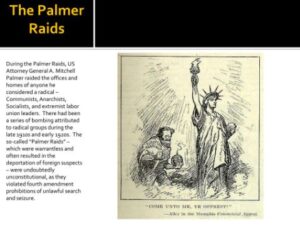 There has been a lot of talk in the news lately about Capitalism verses Socialism or Communism. Capitalism is clear-cut from the other ideologies, but the same cannot be said about communism and socialism. Socialism and communism are often used in place of each other despite being fundamentally different from each other. Capitalism puts the control of one’s assets in the hands of the individual, while socialism and communism put all or most assets in the hands of the government to hand out…or not…as they see fit. In my opinion, the government agencies we have really haven’t done such a great job that I would want to go back and give them more power and control.
There has been a lot of talk in the news lately about Capitalism verses Socialism or Communism. Capitalism is clear-cut from the other ideologies, but the same cannot be said about communism and socialism. Socialism and communism are often used in place of each other despite being fundamentally different from each other. Capitalism puts the control of one’s assets in the hands of the individual, while socialism and communism put all or most assets in the hands of the government to hand out…or not…as they see fit. In my opinion, the government agencies we have really haven’t done such a great job that I would want to go back and give them more power and control.
These days there are many people who would like to switch to Socialism or Communism, but I think it’s because they don’t understand these ideologies. The United States used to understand them very well, and when some of the immigrants tried to bring Socialism and Communism into this counter, in late 1919, and into January 1920, President Woodrow Wilson directed the United States Department of Justice to carry out a series of raids to capture, arrest, and deport these immigrants, because they should never be allowed to come to our 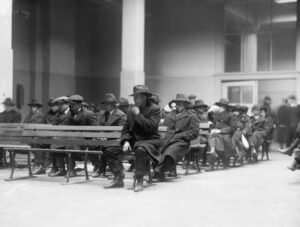 country and they try to change it in the country they chose to leave…especially because the reason they left was because it wasn’t working in their country.
country and they try to change it in the country they chose to leave…especially because the reason they left was because it wasn’t working in their country.
These raids were called the Palmer Raids. The primary targets were Italian immigrants and Eastern European Jewish immigrants with alleged leftist ties, with particular focus on Italian anarchists and immigrant leftist labor activists. Attorney General A Mitchell Palmer spearheaded the operation, and the result was that 3,000 people were arrested. Of the 3,000 arrested, 556 foreign citizens were deported, including a number of prominent leftist leaders.
As often happens in government, what one department likes another doesn’t, so Palmer’s efforts were largely frustrated by officials at the US Department of Labor, which had authority for deportations. They apparently objected to Palmer’s methods. The Palmer Raids during the time of the First Red Scare, a period of fear of and reaction against communists in the US in the years immediately following World War I and the Russian Revolution…the Cold War era. The Palmer Raids were strikes that garnered national attention, and prompted race riots in more than 30 cities, as well as two sets of bombings in April and June 1919, including one bomb mailed to Palmer’s home. Whether the methods were good or bad, I agree that no immigrants should ever 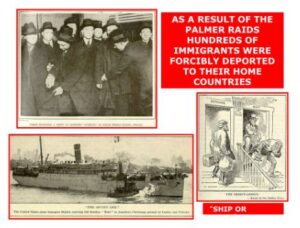 expect to come into this country and then fundamentally change how we run things until it becomes just like the nation that they worked so hard to escape.
expect to come into this country and then fundamentally change how we run things until it becomes just like the nation that they worked so hard to escape.
Unfortunately, Palmer’s raids became the subject of public criticism and led to the rise of the ACLU. Because very little evidence of terrorist bombs was uncovered during the raids, and people were held without legal representation, and some of the raids were carried out without search warrants, the whole operation took on a bad light, even if some of those who were arrested and deported were, in fact, terrorists.
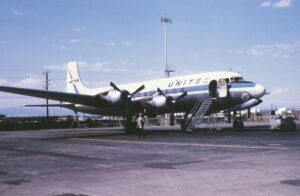 United Air Lines Flight 629, registration N37559, was a Douglas DC-6B aircraft also known as “Mainliner Denver.” The regular route for the flight was from New York City to Portland, Oregon, and then on to Seattle, Washington. This flight made one stop in Chicago and one in Denver. On November 1, 1955, United Airlines Flight 629 left New York City’s La Guardia Airport. It made a scheduled stop in Chicago before continuing to Denver’s Stapleton Airfield and landed at 6:11pm, eleven minutes late. Other than being eleven minutes late, the flight had been completely routine. The plane was refueled with 3,400 US gallons of fuel and had a crew replacement in Denver. Captain Lee Hall, aged 41, a World War II veteran, assumed command of the flight for the segments to Portland and Seattle.
United Air Lines Flight 629, registration N37559, was a Douglas DC-6B aircraft also known as “Mainliner Denver.” The regular route for the flight was from New York City to Portland, Oregon, and then on to Seattle, Washington. This flight made one stop in Chicago and one in Denver. On November 1, 1955, United Airlines Flight 629 left New York City’s La Guardia Airport. It made a scheduled stop in Chicago before continuing to Denver’s Stapleton Airfield and landed at 6:11pm, eleven minutes late. Other than being eleven minutes late, the flight had been completely routine. The plane was refueled with 3,400 US gallons of fuel and had a crew replacement in Denver. Captain Lee Hall, aged 41, a World War II veteran, assumed command of the flight for the segments to Portland and Seattle.
The flight departed Denver at 6:52pm. The flight’s last transmission came at 6:56pm, stating it was passing the Denver omni. Then, just seven minutes later, the air traffic controllers at Stapleton saw two bright lights suddenly appear in the sky north-northwest of the airport. Then, 30 to 45 seconds later, the lights fell to the ground at roughly the same speed…followed by a very bright flash originating at or near the ground. The flash was so intense that it lit up the base of the clouds 10,000 feet above the ground. The whole thing was quite strange, because there were no distress calls from aircraft in the area. They immediately contacted all aircraft flying in the area. The received responses from all the flights, except for Flight 629. The crash of Flight 629 killed all 39 passengers and five crew members.
There was nothing wrong with the plane. The pilots were not ill, nor were they insane. So, what could have brought down the plane? The initial investigation left the authorities stumped. The tail section had apparently been cleanly severed from the plane, almost as if it were cut off by a knife. The FBI consulted the Civil 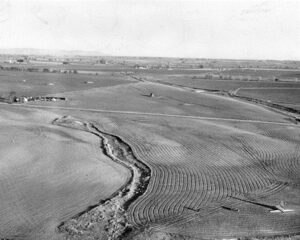 Aeronautics Board (CAB) regarding the tail section. The eyewitnesses all said the same thing. They saw a fiery explosion in the air with flares streaming down and a second explosion on impact. That would also explain the two lights falling to the ground at about the same speed, but separately. It became very apparent that there had been an explosion mid-air, that actually caused the crash, but what caused the explosion.
Aeronautics Board (CAB) regarding the tail section. The eyewitnesses all said the same thing. They saw a fiery explosion in the air with flares streaming down and a second explosion on impact. That would also explain the two lights falling to the ground at about the same speed, but separately. It became very apparent that there had been an explosion mid-air, that actually caused the crash, but what caused the explosion.
The investigation focused on the luggage and a possible bomb. They looked at passengers with insurance. The focus moved to Denver locals, looking for personal enemies. One insured was local resident Daisie Eldora King, a 53-year-old Denver businesswoman who was traveling to Alaska to visit her daughter. They located her handbag and found a number of newspaper clippings containing information about King’s son, John Gilbert Graham, who had been arrested on a forgery charge in Denver in 1951. Graham was always bitter over his childhood. His mother had placed him in an orphanage as a child. Strangely, he alone was the beneficiary of both her life insurance policies and her will. Agents also discovered that one of Mrs King’s restaurants, the Crown-A Drive-In in Denver, had been badly damaged in an explosion. The suspicions were growing. Graham had insured the restaurant and then collected on the property insurance following the blast.
Agents searched Graham’s house and automobile. In the garage they found wire and other bomb making parts that were identical to those found in the wreckage. They also found an additional $37,500 ($379,300 today) in life insurance policies. The problem…Mrs King had not signed either these policies or those purchased at the airport, rendering them worthless. Graham denied putting a bomb in his mother’s luggage, saying she had packed it herself. His wife, Gloria contradicted his story, saying that Graham had wrapped a “present” for his 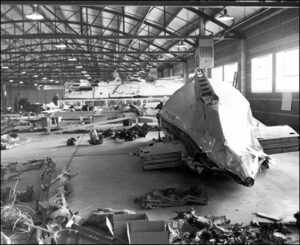 mother on the morning of Mrs King’s flight. Finally faced with mounting evidence against him, Graham admitted to having placed the bomb in his mother’s suitcase, telling the police on November 13, 1955, “I then wrapped about three or four feet of binding cord around the sack of dynamite to hold the dynamite sticks in place around the caps. The purpose of the two caps was in case one of the caps failed to function and ignite the dynamite … I placed the suitcase in the trunk of my car with another smaller suitcase…which my mother had packed to take with her on the trip.” The hatred and bitterness of one man, took the lives of 44 people, and destroyed the lives of their loved ones.
mother on the morning of Mrs King’s flight. Finally faced with mounting evidence against him, Graham admitted to having placed the bomb in his mother’s suitcase, telling the police on November 13, 1955, “I then wrapped about three or four feet of binding cord around the sack of dynamite to hold the dynamite sticks in place around the caps. The purpose of the two caps was in case one of the caps failed to function and ignite the dynamite … I placed the suitcase in the trunk of my car with another smaller suitcase…which my mother had packed to take with her on the trip.” The hatred and bitterness of one man, took the lives of 44 people, and destroyed the lives of their loved ones.
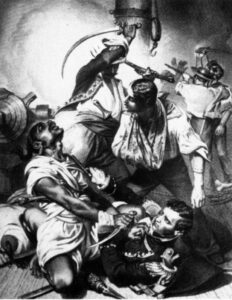
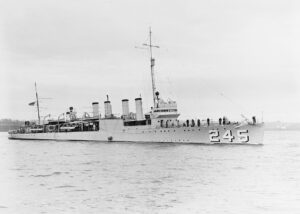 It is common practice in the military to name destroyers (DD) and destroyer Escorts (DE) after Navy and Marine Corps heroes. The USS Reuben James (DD-245) was a four-funnel (four stack) Clemson-class destroyer made after World War I, and it was the first of three US Navy ships named for Boatswain’s Mate Reuben James (1776–1838), who distinguished himself fighting in the First Barbary War. Apparently, on August 3, 1804, James put himself between his commanding officer, Lieutenant Stephen Decatur and the sword of a Tripolitan sailor, who was trying to defend his commander. When James stepped between the descending sword and his commander, he took the blow to his head. Amazingly, the blow did not kill him, and he recovered later to continue serving in the Navy.
It is common practice in the military to name destroyers (DD) and destroyer Escorts (DE) after Navy and Marine Corps heroes. The USS Reuben James (DD-245) was a four-funnel (four stack) Clemson-class destroyer made after World War I, and it was the first of three US Navy ships named for Boatswain’s Mate Reuben James (1776–1838), who distinguished himself fighting in the First Barbary War. Apparently, on August 3, 1804, James put himself between his commanding officer, Lieutenant Stephen Decatur and the sword of a Tripolitan sailor, who was trying to defend his commander. When James stepped between the descending sword and his commander, he took the blow to his head. Amazingly, the blow did not kill him, and he recovered later to continue serving in the Navy.
The Destroyer named after Boatswain’s Mate Reuben James, was the first sunk by hostile action in the European Theater of World War II. The USS Reuben James was laid down on April 2, 1919, by the New York Shipbuilding Corporation of Camden, New Jersey, launched on October 4, 1919, and commissioned on September 24, 1920. the ship was assigned to the Atlantic Fleet. Mainly, it was being used in the Mediterranean Sea during 1921–1922. The ship went from Newport, Rhode Island, on November 30, 1920, to Zelenika, Yugoslavia and arrived on December 18th. It operated in the Adriatic Sea and the Mediterranean out of Zelenika and Gruz (Dubrovnik), Yugoslavia, assisting refugees and participating in post-World War I investigations during the spring and summer of 1921. Then, it joined the protected cruiser Olympia at ceremonies marking the return of the Unknown Soldier to the United States in October 1921 at Le Havre. From October 29, 1921, to February 3, 1922, it assisted the American Relief Administration in its efforts to relieve hunger and misery at Danzig. After completing its tour of duty in the Mediterranean, it departed Gibraltar on July 17th.
Following its tour in the Mediterranean, the ship was based out of New York City, where it routinely patrolled the Nicaraguan coast to prevent the delivery of weapons to revolutionaries in early 1926. During the spring of 1929, it participated in fleet maneuvers that helped develop naval airpower. On January 20, 1931, the Reuben James was
decommissioned at Philadelphia, only to be recommissioned on March 9, 1932. The ship again operated in the Atlantic Ocean and the Caribbean Sea, patrolling Cuban waters during the coup by Fulgencio Batista. Then, in 1934, it was transferred to San Diego. After maneuvers that evaluated aircraft carriers, the Reuben James returned to the Atlantic Fleet in January 1939.
Upon the beginning of World War II in Europe in September 1939, but before the United States joined in the fight, the Reuben James was assigned to the Neutrality Patrol, guarding the Atlantic and Caribbean approaches to the American coast. The ship joined the force established to escort convoys sailing to Great Britain in March 1941. With U-Boat attacks on the rise, this force began escorting convoys as far as Iceland, after which the convoys became the responsibility of British escorts. At that time, it was based at Hvalfjordur, Iceland, commanded by Lieutenant Commander Heywood Lane Edwards.
It would be the escort post that would be the ship in the wrong place at the wrong time. On October 23rd, it sailed from Naval Station Argentia, Newfoundland, with four other destroyers, escorting eastbound Convoy HX 156. All seemed to be going well until, at dawn on October 31st, the Reuben James was torpedoed near Iceland by German U-Boat U-552 commanded by Kapitänleutnant Erich Topp. The Reuben James had positioned itself between an ammunition ship in the convoy and the known position of a German “wolfpack.” The “wolfpack” was a group of submarines poised to attack the convoy. Apparently, the destroyer was not flying the Ensign of the United States, that might have saved it…or maybe not, since it was in the process of dropping depth charges on another U-boat when U-552 engaged. The Reuben James was hit forward by a torpedo meant for a merchant ship and the torpedo blew the entire bow off when a magazine exploded upon the torpedoes impact. The bow of the Reuban James sank immediately. The aft section floated for five minutes before going down. I can only 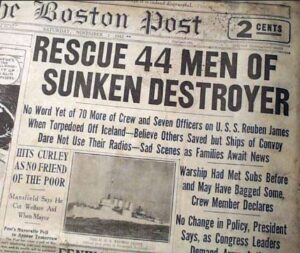
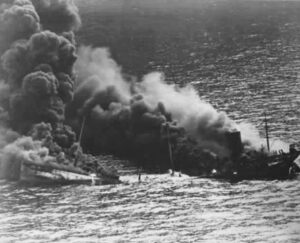 imagine the shock of those around them when the ship was gone so quickly. USS Reuben James carried a crew of seven officers and 136 enlisted men. They also had one enlisted passenger. Of the total of 144 men on board, 100 were killed, including all the officers. Only 44 enlisted men survived the attack. It was the first US warship sunk in World War II, and strangely, the destroyer was sunk before the United States had officially joined the war.
imagine the shock of those around them when the ship was gone so quickly. USS Reuben James carried a crew of seven officers and 136 enlisted men. They also had one enlisted passenger. Of the total of 144 men on board, 100 were killed, including all the officers. Only 44 enlisted men survived the attack. It was the first US warship sunk in World War II, and strangely, the destroyer was sunk before the United States had officially joined the war.
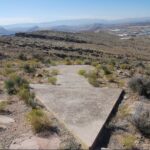
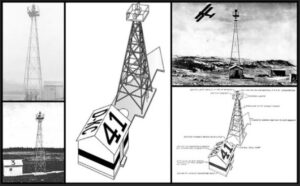 A number of years ago, I had the opportunity to go on a couple of business trips with my boss, Jim Stengel, in his plane. At that time, he introduced me to aviation charts, and I found them very interesting. You could see every airport on them, even the small private airports. You could also see every river, lake, and even pond, and they actually looked right on the map. I suppose the shapes would be off these days, due to droughts and such, but with GPS, I suppose they aren’t as necessary. Aviation charts could almost be considered a novelty now.
A number of years ago, I had the opportunity to go on a couple of business trips with my boss, Jim Stengel, in his plane. At that time, he introduced me to aviation charts, and I found them very interesting. You could see every airport on them, even the small private airports. You could also see every river, lake, and even pond, and they actually looked right on the map. I suppose the shapes would be off these days, due to droughts and such, but with GPS, I suppose they aren’t as necessary. Aviation charts could almost be considered a novelty now.
These days airmail is common, but on August 20, 1920, when the United States opened its first coast-to-coast airmail delivery route, we were just 60 years past the time when the Pony Express closed up shop. To me that is astounding…from horses to airplanes in just 60 years. When airmail got started, they didn’t have any of those aviation charts that had fascinated me on those flights with Jim. In those days, pilots had to navigate by sight…yikes!! Just imagine flying in bad weather, not to mention night flying, which was just about impossible. Some brainstorming was needed.
The Postal Service came up with a unique navigational system. The world’s first ground-based civilian navigation system was made up of a series of lighted beacons that extended from New York to San Francisco. I would think the pilots would have to be quite experienced to follow this plan. The plan included a series of 70-foot concrete arrows, placed ten miles apart from coast to coast. The arrows were painted bright yellow, and at the center of each arrow, stood a 51-foot steel tower. On top of the tower was a million-candlepower rotating beacon. Below the rotating light were two course lights pointing forward and backward along the arrow. The course lights flashed a code to identify the beacon’s number. A generator shed at the tail, or feather end of each arrow powered the beacon and lights, if that became necessary.
Like the railroad, the Airmail system was built in stages. By 1924, just a year after Congress funded it, the line of giant concrete markers stretched from Rock Springs, Wyoming to Cleveland, Ohio. The next summer, it reached all the way to New York and then, by 1929, it extended all the way to San Francisco. It worked so well, that in 1926, the new Aeronautics Branch in the Department of Commerce, now known as United States Postal Service, proposed a 650-mile air mail route linking Los Angeles to Salt Lake City. That route was designated as Contract Air Mail Route 4 (CAM-4). The system seemed well on its way to modernizing mail delivery forever, but
 before long, the advances in communication and navigation technology made the big arrows obsolete, as new technology will. By the 1940s, the Commerce Department decommissioned the beacons. To help the war effort, the steel towers were torn down and sent to be used elsewhere. Today, many of the arrows have been removed, but there are still a few that remain. I suppose if you spent some time scanning Google Earth, or flying along the old routes, you might be able to see a few of these old pieces of history.
before long, the advances in communication and navigation technology made the big arrows obsolete, as new technology will. By the 1940s, the Commerce Department decommissioned the beacons. To help the war effort, the steel towers were torn down and sent to be used elsewhere. Today, many of the arrows have been removed, but there are still a few that remain. I suppose if you spent some time scanning Google Earth, or flying along the old routes, you might be able to see a few of these old pieces of history.

![]()
 My aunt, Sandy Patton is the youngest of my grandparents, George and Hattie Byer’s children. Life for a youngest child is normally very different than that of the oldest child…especially in a large family. My grandparents had nine children. From almost the time Aunt Sandy was three years old, basically from the time her first memory, there were babies in the household. The older children had similar experiences, but it’s a bit different when the babies are younger siblings…or maybe it isn’t. The nieces and nephews were there a lot, but they did go home too. Nevertheless, as a young girl, she always had playmates…at least when she could play.
My aunt, Sandy Patton is the youngest of my grandparents, George and Hattie Byer’s children. Life for a youngest child is normally very different than that of the oldest child…especially in a large family. My grandparents had nine children. From almost the time Aunt Sandy was three years old, basically from the time her first memory, there were babies in the household. The older children had similar experiences, but it’s a bit different when the babies are younger siblings…or maybe it isn’t. The nieces and nephews were there a lot, but they did go home too. Nevertheless, as a young girl, she always had playmates…at least when she could play.
Aunt Sandy was a sickly child, and often missed school, so in reality, her best friend was her mom. They spent a lot of time together while her mom care for her ailing daughter. When a child is sick, they need bedrest, but when they aren’t sleeping…that can make for long boring days. So, to ease the boredom, Grandma Byer told her daughter stories of the past…Grandma’s past and Aunt Sandy’s heritage. Some of the stories were about 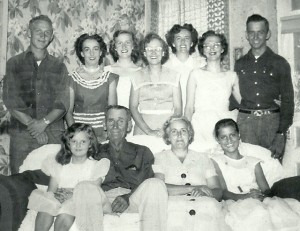
 Grandma’s childhood years, and others were about her ancestors. Aunt Sandy learned about the Cowboys and Indians, the lives of farmers and homesteaders, early automobiles, and about Aunt Sandy’s older siblings’ antics. When she wasn’t sick, Aunt Sandy had to take on the job of catching up on her studies. I don’t imagine that was fun, and I would think that there were many times when Aunt Sandy, thought about quitting school, but she didn’t…and maybe Grandma wouldn’t have let her do that. Whether Aunt Sandy liked school or not really made no difference, because if there was one subject she did like history. She loved hearing about the past, probably because her mom made it so real to her…almost like she was right there.
Grandma’s childhood years, and others were about her ancestors. Aunt Sandy learned about the Cowboys and Indians, the lives of farmers and homesteaders, early automobiles, and about Aunt Sandy’s older siblings’ antics. When she wasn’t sick, Aunt Sandy had to take on the job of catching up on her studies. I don’t imagine that was fun, and I would think that there were many times when Aunt Sandy, thought about quitting school, but she didn’t…and maybe Grandma wouldn’t have let her do that. Whether Aunt Sandy liked school or not really made no difference, because if there was one subject she did like history. She loved hearing about the past, probably because her mom made it so real to her…almost like she was right there.
Aunt Sandy still loves hearing about family today, and really enjoys hearing about all the new additions, and the exciting things everyone is doing. She is the keeper of traditions, which stands to reason, since she is the youngest. It seems like tradition always falls to the youngest child eventually…at least until they pass the baton 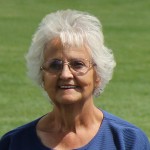
 to the next generation. Sometimes it’s hard to pass that baton, because you never know if there will be a child of the next generation who is willing to pick that baton up and run with it. It was the hope of her parents, my grandparents that we always find a way to keep the family as close as possible. Aunt Sandy tried her best, and hopefully now, we will continue to try our best. Today is Aunt Sandy’s 77th birthday. Happy birthday Aunt Sandy!! Have a great day!! We love you!!
to the next generation. Sometimes it’s hard to pass that baton, because you never know if there will be a child of the next generation who is willing to pick that baton up and run with it. It was the hope of her parents, my grandparents that we always find a way to keep the family as close as possible. Aunt Sandy tried her best, and hopefully now, we will continue to try our best. Today is Aunt Sandy’s 77th birthday. Happy birthday Aunt Sandy!! Have a great day!! We love you!!
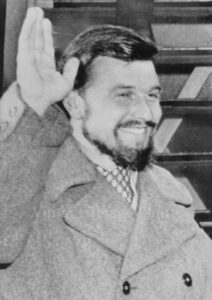 To most of us, committing espionage against our own country is…unthinkable, but there are those among us who wouldn’t give that a second thought. I think most countries have spies who do their best to find out information about another country, and I suppose that by design, that would mean that someone would have to commit espionage. I guess the two would go hand in hand, and it would depend on just how loyal a person was as to the limits they would go.
To most of us, committing espionage against our own country is…unthinkable, but there are those among us who wouldn’t give that a second thought. I think most countries have spies who do their best to find out information about another country, and I suppose that by design, that would mean that someone would have to commit espionage. I guess the two would go hand in hand, and it would depend on just how loyal a person was as to the limits they would go.
George Blake, who was born George Behar on November 11, 1922, was a British MI6 agent, and at one time thought to be a loyal agent, but during his time as a prisoner of war in Seoul, during the Korean War, he was apparently converted into a Communist, and strategically set up to be a double-agent. I suppose there is a number of prisoners of war who traded secrets for life and freedom from torture, and some who honestly changed their viewpoint, but to me it is outrageous. George Blake must 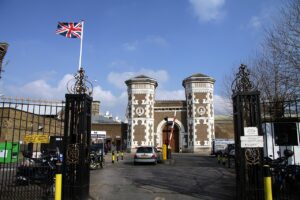 not have seen it that way, because he was a double-agent until he got caught in 1961.
not have seen it that way, because he was a double-agent until he got caught in 1961.
During his active double-agent years, he is believed to have betrayed the names of more than 40 British agents to the Soviets. Many of those he betrayed disappeared and were thought to have been executed. His betrayals basically destroyed British secret service operations in the Middle East. It must have been almost impossible to get agents to work in that region. Blake is believed to have passed on the names of almost every British agent working in Cairo, Damascus, and Beirut. Lord Parker, Lord 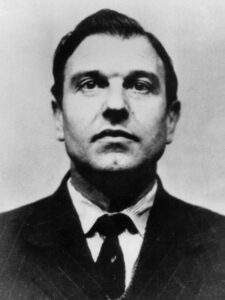 Chief Justice, the judge sentencing him, likened his actions to treason, and said, “It is one of the worst that can be envisaged other than in a time of war.” Blake was charged under the Official Secrets Act in May 1961. Blake pleaded guilty to five counts of passing secrets to the Soviet authorities during his trial, part of which was held in camera.
Chief Justice, the judge sentencing him, likened his actions to treason, and said, “It is one of the worst that can be envisaged other than in a time of war.” Blake was charged under the Official Secrets Act in May 1961. Blake pleaded guilty to five counts of passing secrets to the Soviet authorities during his trial, part of which was held in camera.
In 1966, Blake escaped from Wormwood Scrubs prison after serving five years of his sentence and having been removed from the list of likely escapers after only a year. Apparently, his supposed acceptance of his exceptionally long sentence lulled wardens into a false sense of security. It is assumed that he had help from the Soviet Union, and after his escape, he was quickly whisked away to the Soviet Union, where he lived out his life. He passed away in Moscow, Russia on December 26, 2020, at the age of 98 years.
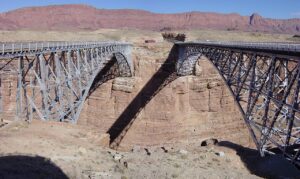
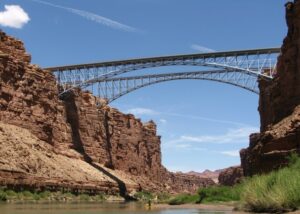 The Navajo Bridge is a pair of twin steel spandrel arch bridges that cross the Colorado River in the Grand Canyon National Park (near Lees Ferry) in northern Coconino County, Arizona. The first bridge was officially named the Grand Canyon Bridge when it was dedicated on June 14, 1929, but five years later in 1934, the state legislature changed the name to Navajo Bridge. When the first bridge was built, it was really too narrow to be used for the vehicular traffic of today and almost too narrow at the time it was built. That is really what sparked the need for a second bridge, and the newer of the two spans is well able to carry vehicular traffic on US Route 89A over Marble Canyon between Bitter Springs and Jacob Lake, allowing travel into a remote Arizona Strip region north of the Colorado River including the North Rim of Grand Canyon National Park. Sadly, during construction of the first bridge, a worker named Lafe McDaniel died after falling 467 feet to the Colorado River below. Initially, a safety netting was considered, but supervisors had rejected the idea, believing that it would catch on fire from falling hot rivets.
The Navajo Bridge is a pair of twin steel spandrel arch bridges that cross the Colorado River in the Grand Canyon National Park (near Lees Ferry) in northern Coconino County, Arizona. The first bridge was officially named the Grand Canyon Bridge when it was dedicated on June 14, 1929, but five years later in 1934, the state legislature changed the name to Navajo Bridge. When the first bridge was built, it was really too narrow to be used for the vehicular traffic of today and almost too narrow at the time it was built. That is really what sparked the need for a second bridge, and the newer of the two spans is well able to carry vehicular traffic on US Route 89A over Marble Canyon between Bitter Springs and Jacob Lake, allowing travel into a remote Arizona Strip region north of the Colorado River including the North Rim of Grand Canyon National Park. Sadly, during construction of the first bridge, a worker named Lafe McDaniel died after falling 467 feet to the Colorado River below. Initially, a safety netting was considered, but supervisors had rejected the idea, believing that it would catch on fire from falling hot rivets.
The dual bridges of Navajo Bridge are tied at ninth place among the highest bridges in the United States. Their heights are nearly identical with the original span at a height of 467 feet, and the second span at 470 feet. What really caught my eye was that if you are looking toward the red cliffs from beside the bridges, it looks as if they go straight into the rocks. They don’t, of course. It’s an optical illusion, but it is interesting, and quite pretty. When the second bridge was completed, and was wide enough to handle the modern-day traffic, the original Navajo Bridge was changed to allow only pedestrian and equestrian use, and also an interpretive center 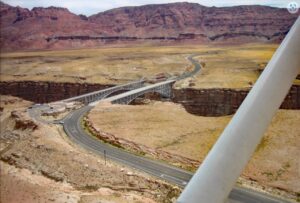
 was constructed on the west side to showcase the historical nature of the bridge and early crossing of the Colorado River. In addition, the original bridge has been designated as a Historic Civil Engineering Landmark and was placed on the National Register of Historic Places on August 13, 1981. In 1996, California condors were reintroduced to the area and can sometimes be seen on and around Navajo Bridge, making it even more interesting to visit.
was constructed on the west side to showcase the historical nature of the bridge and early crossing of the Colorado River. In addition, the original bridge has been designated as a Historic Civil Engineering Landmark and was placed on the National Register of Historic Places on August 13, 1981. In 1996, California condors were reintroduced to the area and can sometimes be seen on and around Navajo Bridge, making it even more interesting to visit.
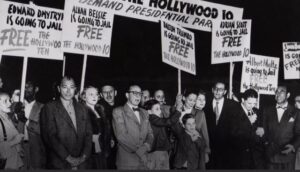 In a very different time in America, being a communist was not accepted, and it really shouldn’t be accepted now, but that is not the opinion of every person in the United States today. Nevertheless, on October 20, 1947, saw the beginning of the notorious Red Scare. At that time, a Congressional committee began investigating the Communist influence that was, or at least was suspected of infiltrating one of the world’s richest and most glamorous communities…Hollywood, California.
In a very different time in America, being a communist was not accepted, and it really shouldn’t be accepted now, but that is not the opinion of every person in the United States today. Nevertheless, on October 20, 1947, saw the beginning of the notorious Red Scare. At that time, a Congressional committee began investigating the Communist influence that was, or at least was suspected of infiltrating one of the world’s richest and most glamorous communities…Hollywood, California.
One of the greatest fears after World War II, was that the Cold War began to heat up between the United States and the communist-controlled Soviet Union. Conservatives in Washington were working hard to remove any communists in government. Then, they set their sights on those people who were alleged “Reds” in the liberal movie industry. During the investigation that began in October 1947, the House Un-American Activities Committee (HUAC) questioned a number of prominent people. During the interviews, the committee asked point-blank, “Are you or have you ever been a member of the Communist Party?”
It might have been fear or maybe a sense of patriotism, but some witnesses, including director Elia Kazan, 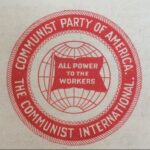 actors Gary Cooper and Robert Taylor, and studio honchos Walt Disney and Jack Warner, all gave the committee names of colleagues they had suspected of being communists. That began a more grueling interrogation of a small group known as the “Hollywood Ten.” All of the “Hollywood Ten” resisted the accusations, complaining that the hearings were illegal and violated their First Amendment rights. The 10 were Alvah Bessie, Herbert Biberman, Lester Cole, Edward Dmytryk, Ring Lardner Jr, John Howard Lawson, Albert Maltz, Samuel Ornitz, Adrian Scott, and Dalton Trumbo. While they weren’t convicted of being communist, they were all convicted of obstructing the investigation and each served jail terms.
actors Gary Cooper and Robert Taylor, and studio honchos Walt Disney and Jack Warner, all gave the committee names of colleagues they had suspected of being communists. That began a more grueling interrogation of a small group known as the “Hollywood Ten.” All of the “Hollywood Ten” resisted the accusations, complaining that the hearings were illegal and violated their First Amendment rights. The 10 were Alvah Bessie, Herbert Biberman, Lester Cole, Edward Dmytryk, Ring Lardner Jr, John Howard Lawson, Albert Maltz, Samuel Ornitz, Adrian Scott, and Dalton Trumbo. While they weren’t convicted of being communist, they were all convicted of obstructing the investigation and each served jail terms.
The Hollywood establishment, after being pressured by Congress, started a blacklist policy. The blacklist involved the practice of denying employment to entertainment industry professionals believed to be or to have been Communists or sympathizers. Actors, screenwriters, directors, musicians, and other American entertainment professionals were barred from work by the studios. This was usually done on the basis of their membership in, or alleged membership in, or sympathy with the Communist Party USA, or their refusal to assist Congressional investigations into party activities. The policy brought about the banning the work of about 325 screenwriters, actors, and directors who had not been cleared by the committee.
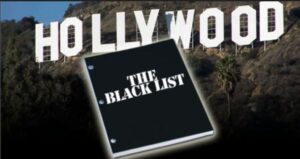 Those blacklisted included composer Aaron Copland, writers Dashiell Hammett, Lillian Hellman, and Dorothy Parker, playwright Arthur Miller, and actor and filmmaker Orson Welles. The policy wasn’t always strictly enforced, and even during the period of its strictest enforcement, from the late 1940s through to the late 1950s. The blacklist was almost never made explicit. It was rather the result of numerous individual decisions by the studios and was not the result of official legal action. Nevertheless, the blacklist quickly and directly damaged or even ended the careers and income of scores of individuals working in the film industry.
Those blacklisted included composer Aaron Copland, writers Dashiell Hammett, Lillian Hellman, and Dorothy Parker, playwright Arthur Miller, and actor and filmmaker Orson Welles. The policy wasn’t always strictly enforced, and even during the period of its strictest enforcement, from the late 1940s through to the late 1950s. The blacklist was almost never made explicit. It was rather the result of numerous individual decisions by the studios and was not the result of official legal action. Nevertheless, the blacklist quickly and directly damaged or even ended the careers and income of scores of individuals working in the film industry.
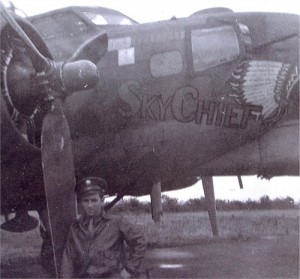
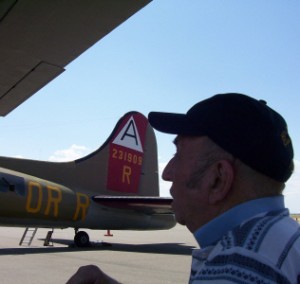 For most World War II history buffs, like me, there is only one bomber worth taking about…the B-17 Bomber. I’m sure there have been many bombers since, but the B-17 will always stand out in my mind. I’m sure that is partly because my dad spent his entire time in World War II as the Top Turret Gunner and Flight Engineer on a B-17G Bomber, stationed at Great Ashfield in Suffolk, England, about nine miles from Bury Saint Edmonds.
For most World War II history buffs, like me, there is only one bomber worth taking about…the B-17 Bomber. I’m sure there have been many bombers since, but the B-17 will always stand out in my mind. I’m sure that is partly because my dad spent his entire time in World War II as the Top Turret Gunner and Flight Engineer on a B-17G Bomber, stationed at Great Ashfield in Suffolk, England, about nine miles from Bury Saint Edmonds.
Dad was so proud of the beautiful, brand-new B-17G Bomber. The thing he might have known, but that I certainly didn’t, is that when those shiny brand-new B-17 Bombers came out and were sent out to battle, they were already considered to be outdated. Of course, outdated, does not mean they couldn’t be used, because they not only could be used, but they were very effective. I suppose that the fact that they were outdated could have meant that they were slower, more awkward, or less accurate, but during World War II, they were very effective, and the people they protected were extremely grateful for their prominent presence on the 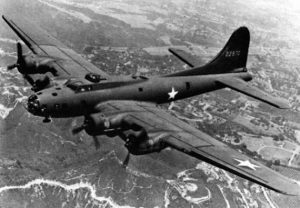
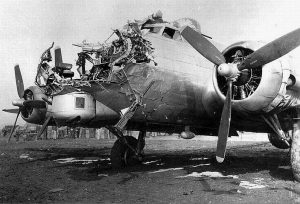 battlefield. Those planes were almost indestructible…short of losing a wing anyway.
battlefield. Those planes were almost indestructible…short of losing a wing anyway.
While the reality is that far more Consolidated B-24 Liberators were produced and were used more extensively than B-17s, both as bombers and in other roles. Nevertheless, the B-17 had a following. It was beloved by so many people…even though it was predominantly used in the Eighth Air Force. Really, it is most likely because the historians, who were mainly focusing on the war in Europe, and who have devoted so much coverage to the Boeing B-17 Flying Fortress, that the B-17 is often thought of as the only American bomber of the war, or at least until the much larger B-29 Superfortress was introduced by Boeing. Still, the B-29 Superfortress, in the minds of many people anyway, couldn’t hold a candle to the B-17 if the minds of the people. In fact, while thousands of Douglas A-20s, North American B-25s, and Martin B-26s, as well as excellent British bombers 
 such as the Lancaster and Wellington, served in all theaters of war, it was The Fort, as it has lovingly been called, that has come to symbolize the air war perhaps more than any other bomber…of any era. For me, the B-17 will always be the most awesome, and greatest bomber ever built. When one flies overhead, I recognize the sound. I can pick one out while it is flying, even if it is too far away to hear the engines. If I had to pick an airplane that will always be iconic, the B-17 is it, and always will be.
such as the Lancaster and Wellington, served in all theaters of war, it was The Fort, as it has lovingly been called, that has come to symbolize the air war perhaps more than any other bomber…of any era. For me, the B-17 will always be the most awesome, and greatest bomber ever built. When one flies overhead, I recognize the sound. I can pick one out while it is flying, even if it is too far away to hear the engines. If I had to pick an airplane that will always be iconic, the B-17 is it, and always will be.
 You can fly near it, walk close to some fences, or zoom in from a far hill, but you cannot enter Menwith Hill Royal Air Force Station for any reason. Not unless you are an ECHELON spies and the NSA, that is. The station was founded in 1954, when the British War Office purchased 550 acres and leased them to the United States. The Cold War, a strange war that “raged” from March 12, 1947, to December 26, 1991, was in full swing when Menwith Hill was established. At the time, the station was used for spying and intelligence-gathering. Now that the Cold War is over, no one knows what goes on there. In fact, concern over the goings on is so high that there have been a large number of protests leading to politicians calling for more transparency about what goes on at Menwith Hill Royal Air Force Station. Many people think that Menwith Hill Royal Air Force Station, which is by far the most secretive piece of land in all of the United Kingdom, needs to be more transparent. Nevertheless, to this day, no one knows for sure what goes on in this military installation.
You can fly near it, walk close to some fences, or zoom in from a far hill, but you cannot enter Menwith Hill Royal Air Force Station for any reason. Not unless you are an ECHELON spies and the NSA, that is. The station was founded in 1954, when the British War Office purchased 550 acres and leased them to the United States. The Cold War, a strange war that “raged” from March 12, 1947, to December 26, 1991, was in full swing when Menwith Hill was established. At the time, the station was used for spying and intelligence-gathering. Now that the Cold War is over, no one knows what goes on there. In fact, concern over the goings on is so high that there have been a large number of protests leading to politicians calling for more transparency about what goes on at Menwith Hill Royal Air Force Station. Many people think that Menwith Hill Royal Air Force Station, which is by far the most secretive piece of land in all of the United Kingdom, needs to be more transparent. Nevertheless, to this day, no one knows for sure what goes on in this military installation.
RAF Menwith Hill is owned by the Ministry of Defence (MoD), but made available to the US Department of Defense (DoD) under the NATO Status of Forces Agreement 1951 and other, undisclosed agreements between the US and British governments. The site acts as a ground station for a number of satellites operated by the US National Reconnaissance Office, on behalf of the NSA, with antennae contained in numerous distinctive white radomes, locally referred to as “the golf balls,” and is alleged to be an element of the ECHELON system. The radomes are really a big part of what gives the installation its air of mystery.
Military installations have existed all over the world for hundreds of years, but not all of them are as secretive as Menwith Hill. It’s likely that we will never be privy to the things that go on there, and that may be a source of contention for years to come. I don’t know how I feel about the secrecy in military installations. In some ways I understand the need, but with secrecy, can come corrupt and dark schemes, as we saw during the Holocaust. Much depends on the integrity of the country, and even more importantly the integrity of the people in charge of the activities that go on there. Even with a country that is trying to do good, there can be evil people both working there, and in charge  of operations, and when evil people are allowed to operate in secrecy, the only logical outcome is disaster.
of operations, and when evil people are allowed to operate in secrecy, the only logical outcome is disaster.
RAF Menwith Hill is one of three main sites operated by the United States across the globe. It operates as a major satellite monitoring station and intelligence gathering location. The other two sites are located in America and Australia, having similar roles and working together with RAF Menwith Hill to develop knowledge around American, British, and Australian interests. The Australian site is known as the Joint Defence Facility Pine Gap. I wonder if operations at the other sites are as secret as they are at RAF Menwith Hill.

